Table of content
Straight to the point: one funnel is not enough.
The secret sauce to reliable, replicable, and scalable success in 2021 and beyond is to run TWO types of sales funnel at the same time.
More precisely, to marry an Evergreen funnel with a Launch funnel. Trust us, it’s a match made in digital heaven.
At Tribe47 we consult on average four new online businesses a month. The most common mistake we’ve been observing is businesses having either just one funnel or none. It’s usually also the most costly mistake — in terms of lost opportunities and missed growth.
In a nutshell: if we were to compare funnels to couples, the Evergreen would be that quiet, reliable, and well-organized partner that holds everything together. On the other hand, the Launch funnel would be the spice of life in the relationship. It’s flirty, it’s unpredictable — keeps things dynamic and covered in biodegradable glitter… making sure the flame doesn’t die out. ????
A perfect combination of trustworthy, yet exciting and fun. The Dream Power Couple — but only when they gel.
Ready to swipe right on them? This guide is for you if:
- You’re a B2C business — it’s a must-read.
- You’re a B2B business — there will be a lot of useful tricks and techniques for you to test out and adapt to your situation.
- Pay extra attention if you’re in e-commerce, online education, or subscription.
B2B vs B2C Marketing
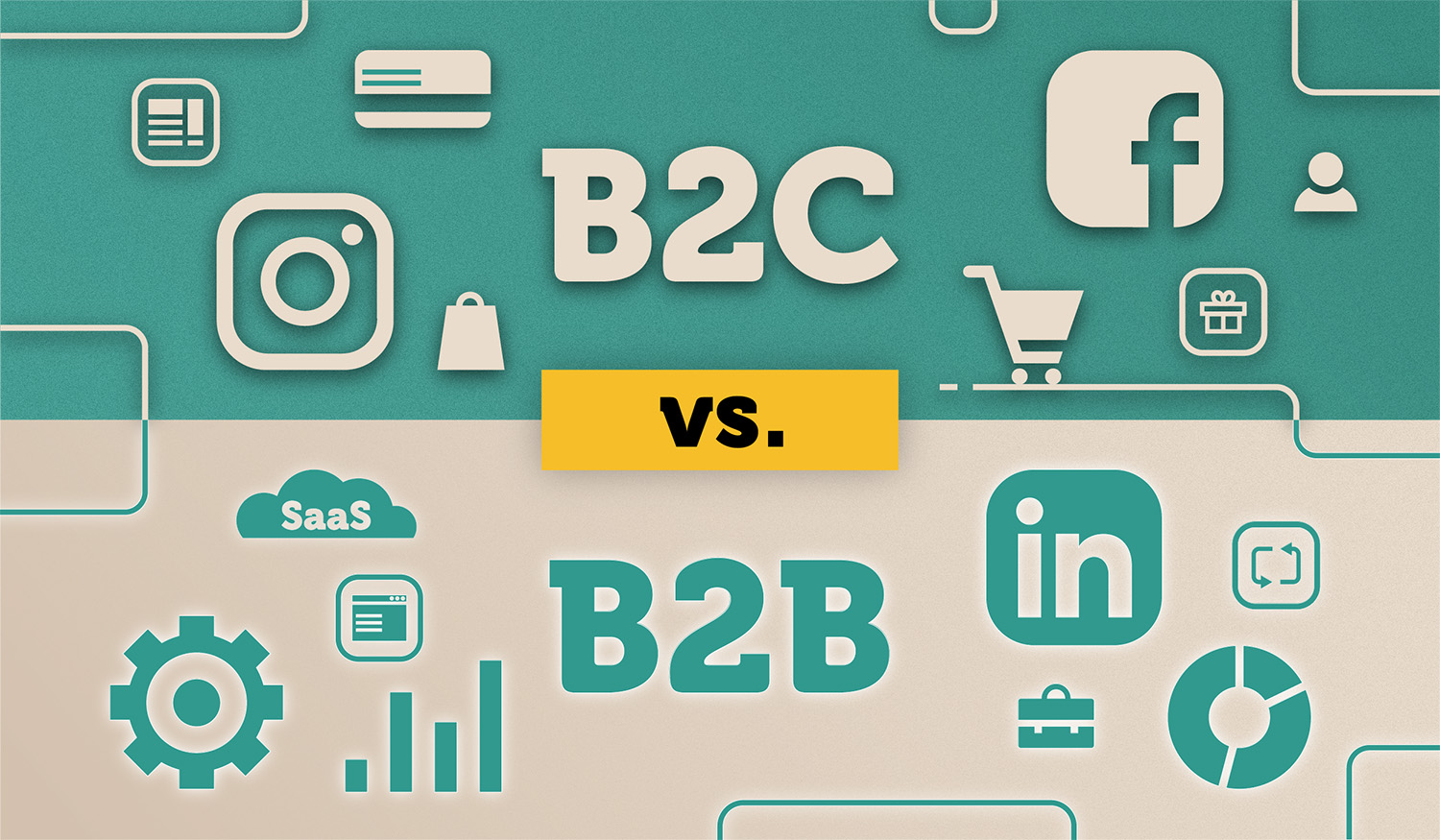
B2C (business to consumer) marketing covers all the interaction and communication between a brand and an individual consumer who (hopefully!) will get a brand’s product or service for personal use.
The consumers need/want your product or service to find a solution to a challenge, resolve a pain point, learn a new skill, satisfy some other desire, or make a dream come true.
Basically, make life a bit easier, more fulfilling, and fun. Which makes B2C marketing intensely personal.
The goal of this type of marketing is to create a trustworthy relationship with your audience, so they feel you understand them and are comfortable buying from you — not just once, but over and over again.
How does it compare to B2B (business-to-business) marketing?
The biggest difference comes down to the end-user and communication channels. With B2B you have to target the right decision-makers — like a CEO, team manager, head of HR, etc. As a result, you’ll have to play on different social media platforms (Linkedin instead of TikTok). You’ll have to adjust the language and visuals to convey trust, authority, and professionalism above everything else.
And a juicy ROI, too.
With B2C marketing, you usually have to convert only one person. Please mind though, there will be exceptions to it. If it’s a bigger purchase that leaves a visible mark on a household’s budget (like new kitchen equipment or premium membership) OR it demands significant amounts of time (like an online certification/degree), it might require a green light from your prospect’s partner or boss.
???? PRO TIP #1
Whether it’s B2B or B2C, it’s still all about people, so include all the decision-makers in your marketing strategy and communication. Be it an HR manager asking for CEO’s approval or a spouse tied by a shared household budget and schedule — address them in your copy.
You can do it straightforwardly (in a clearly titled section or in the FAQ) or more subtly by dropping hints across the board. The cheekiest approach would be to create a little guide to help your leads and prospects convince other decision-makers.
Whatever you choose, help them to clearly present the benefits and emphasize the (financial, physical, emotional) return on investment.
The Ultimate B2C Strategy — The Digital Funnel 3.0
For the purpose of this guide, we’ll focus on B2C funnels, but your marketing team will be able to easily adapt our tips and techniques to your B2B marketing.
There are many B2C strategies — from improving your SEO to building an influencers’ network — but from over a decade of experience I can tell you upfront:
A modern digital sales funnel trumps them all.
When I say modern, I mean The Funnel 3.0, focused on ungated content, multichannel traffic campaigns, video production, and more. If that’s a fairly unfamiliar concept, read this blog post before you proceed with this guide.
Two Paths. Six Rockstars.
As mentioned above, we divide Funnel 3.0 into two types: the Evergreen and the Launch funnel. These together form 6 sizzling hot categories.
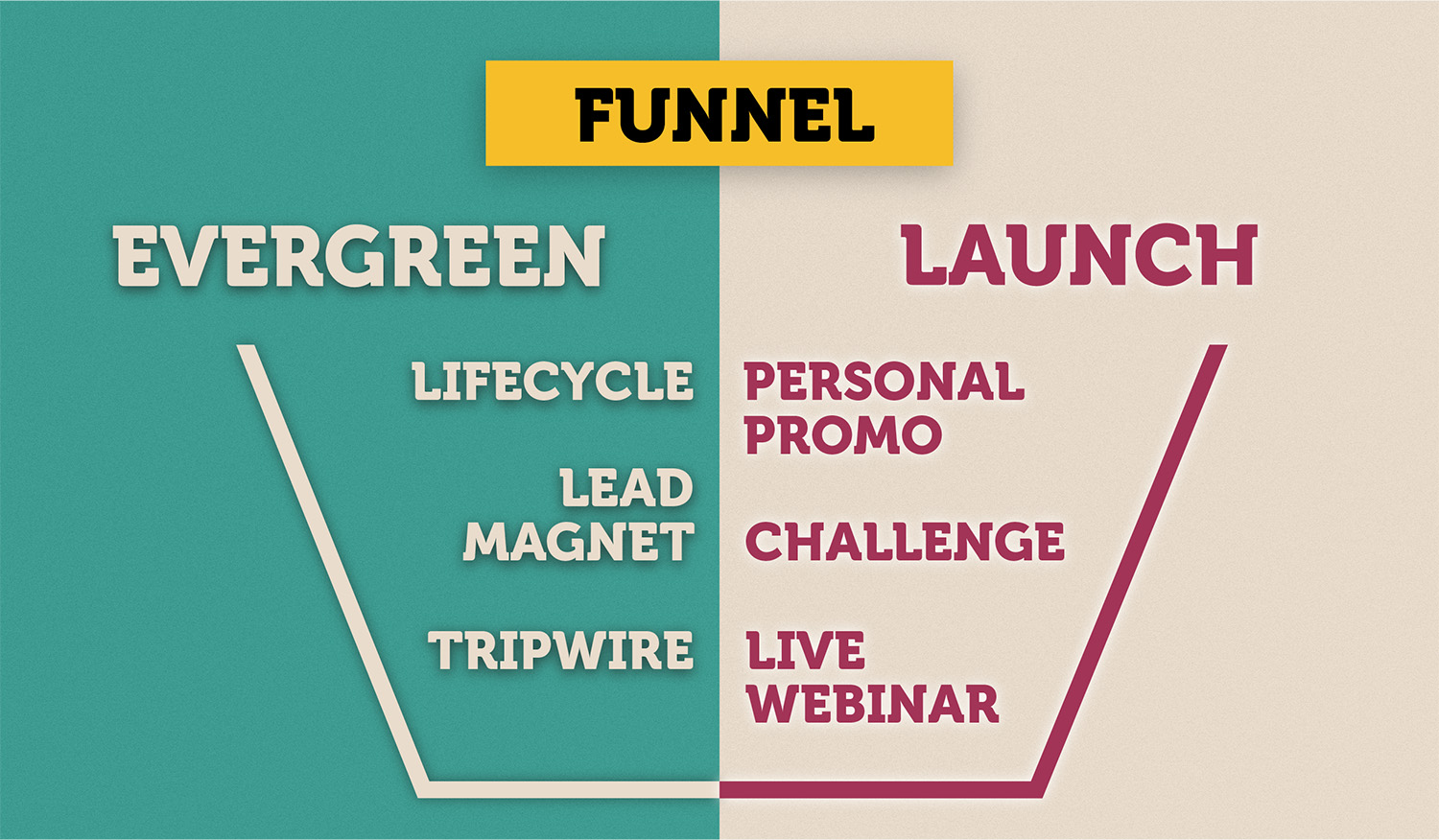
The Evergreen Funnel
Typically, it’s a type of conversion/sales funnel where you gradually turn strangers into curious visitors, then into leads, then into satisfied customers, and finally into excited fans deploying word of mouth for you. There will be some exceptions to that flow, as you’ll see in a second.
The main thing: it’s an automated process of client acquisition, not dependent on season or your daily actions (if set upright, it will become your passive income). In theory, it works fine all the time, in practice you want to have an eye on it because your industry’s or audience’s circumstances might gradually or suddenly change (like we experienced with COVID-19 and the global lockdown, for example).
What’s important, it takes care of the entire customer acquisition process — from building brand awareness to the first sale to maximizing the following sales and retention.
Since it addresses the coldest audience and creates brand awareness, you shouldn’t obsess about getting the lowest possible customer acquisition cost (CAC). That being said, you want to know when too much is too much.
In the long run, there are two important metrics to pay attention to and maintain in a 3:1 ratio — especially when you used to have an Evergreen that was making you 6+ figures… and then suddenly stopped.
Anyway, as mentioned above, you want that Power Couple effect — so your Evergreen should never roam alone. Unleash the Launch funnel’s charm and watch the sale numbers soar.
Here’s a visual example of what it can look like:
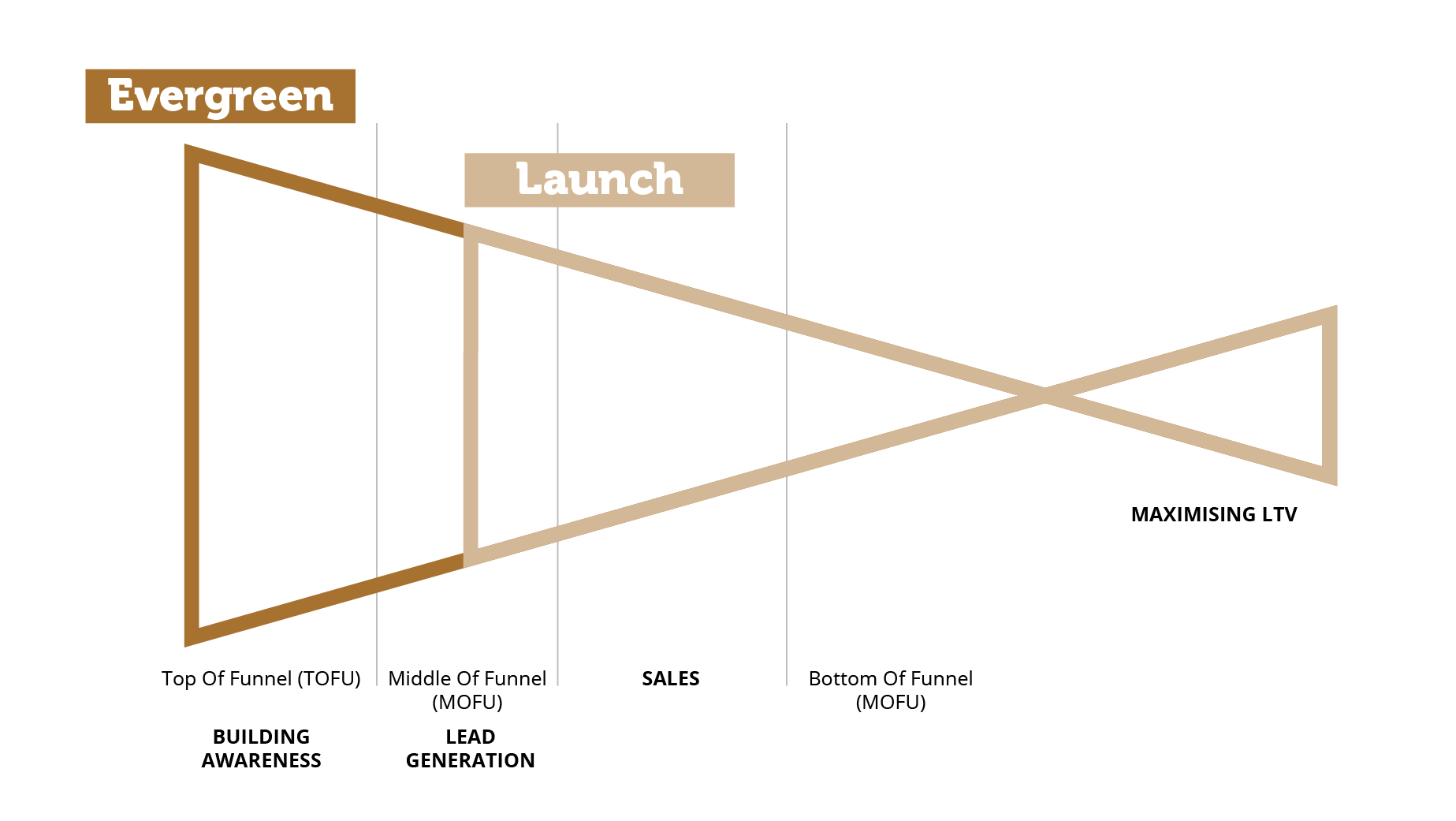
Now, the Launch funnel is a proficient attention seeker — but we’re going to stay focused on the Evergreen for now. There are 3 categories to explore.
???? PRO TIP #2
You’ll see “for whom” recommendations for each section, but that’s exactly what they are — merely suggestions for when you want to play it safe. If you like to innovate and experiment though, go ahead and readjust them. Mix and match them. This is the most satisfying bit about digital marketing — it’s all your playground.
1. Lifecycle funnel
For whom?
E-commerce with physical (or any “straightforward”) products
In this funnel, you want to showcase the product right away, before even building brand awareness. Improve your SEO, use multiple channels, and send the cold traffic to one of the offer pages — like a single product page, product category page, or a content piece (pre-sale engagement page).
Btw. If all these words like paid traffic, CAC, and targeting are not your daily bread and butter, we highly recommend you check our Performance Team’s piece on how to effectively fuel your funnel with quality traffic.
Back to Lifecycle. Give your audience a chance to buy straight away, if they feel inclined to. They might want to sign up for your newsletter first, hoping for a welcome discount — let them do that.
Whether they buy or not, deploy remarketing techniques like abandoned browsing or checkout remarketing, new subscribers, or new client remarketing. Don’t start chilling just because they bought from you — you want to maximize the sales by boosting conversion and increasing purchase frequency.
This funnel works great with really straightforward products — anything that your audience can comprehend at first glance. You’re aiming for a great first impression. If you confuse them, you’re gonna lose them. So make sure your visuals, design, and descriptions — both in the ads and on the websites — are on point.
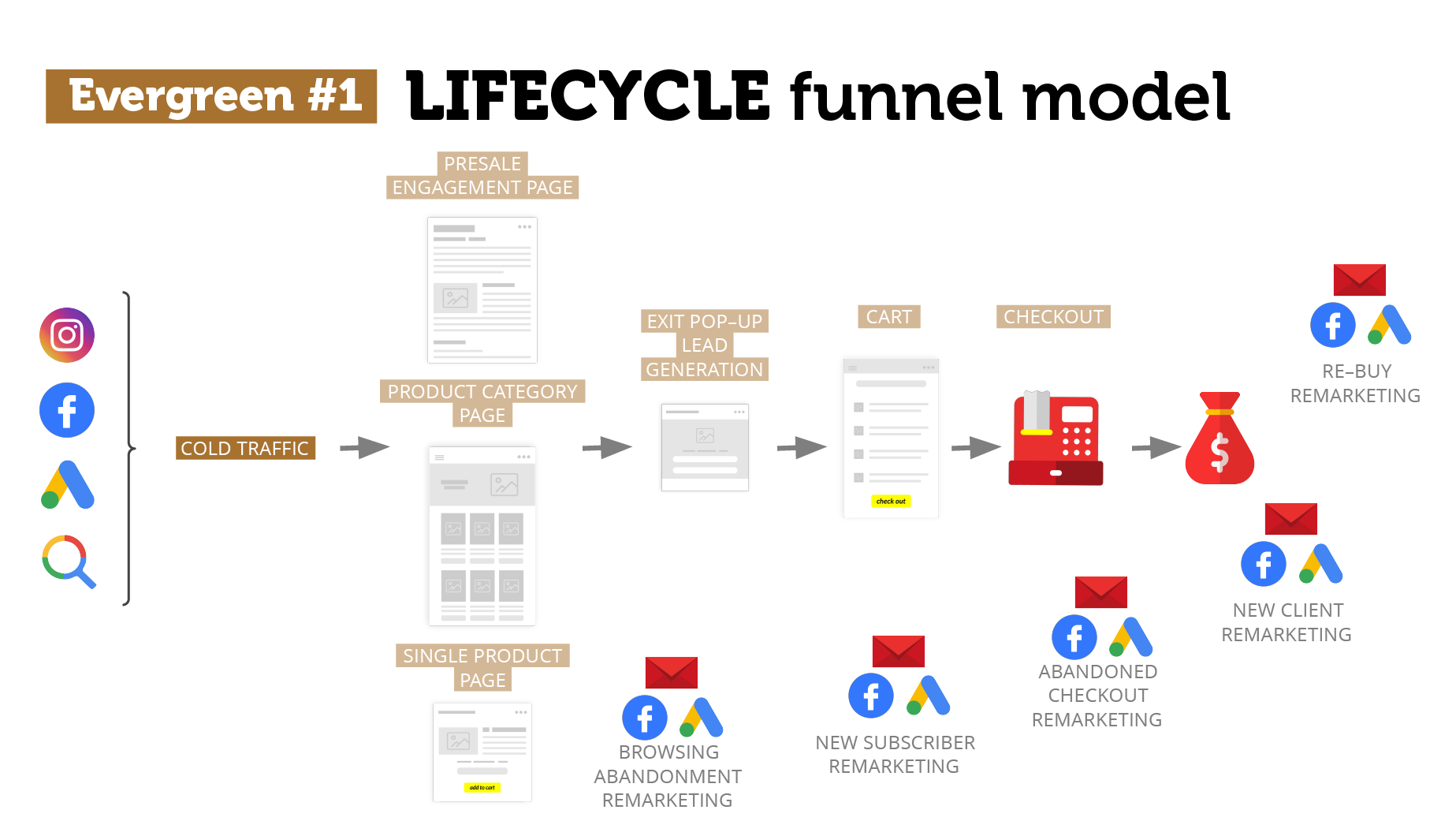
2. Lead Magnet Funnel
For whom?
Online Education
The most important difference between this funnel and the previous one is that here you intentionally and skillfully postpone the moment of showing your product to a potential customer — you’re building a relationship with them, brand awareness, and momentum.
Send cold traffic to the ungated content — of high quality and value! — and then give them something extra (Lead Magnet) in exchange for their email address. The most important part of this funnel is gathering and nurturing leads through content and education. You want your leads to understand your vibe and values before you show them your product. Insert here an irresistible nurturing (and sales!) email sequence that will keep them hooked and engaged.
There are two types of a Lead Magnet to play with — and I’d recommend combining them for the best results:
- Low engagement & time investment: checklist; quiz; small ebook; practical tips in your weekly newsletter etc.
- High engagement & time investment: a big ebook; an automated (pre-recorded) webinar; a free trial etc.
What about the remarketing techniques? They’re kicking in as soon as your prospect makes the first contact with your ungated content and then transforms into new subscriber remarketing, sales campaign, new customer remarketing, and so on.
This type of funnel works great in online education and SaaS (software-as-a-service) businesses. Products like online courses, subscriptions, or memberships are rarely straightforward and it takes some effort to present their full value — especially if they sport a higher price tag.
Again, this flow has been created for a B2C business. If you’re in B2B — play with it and split-test different options. You can still make it work.
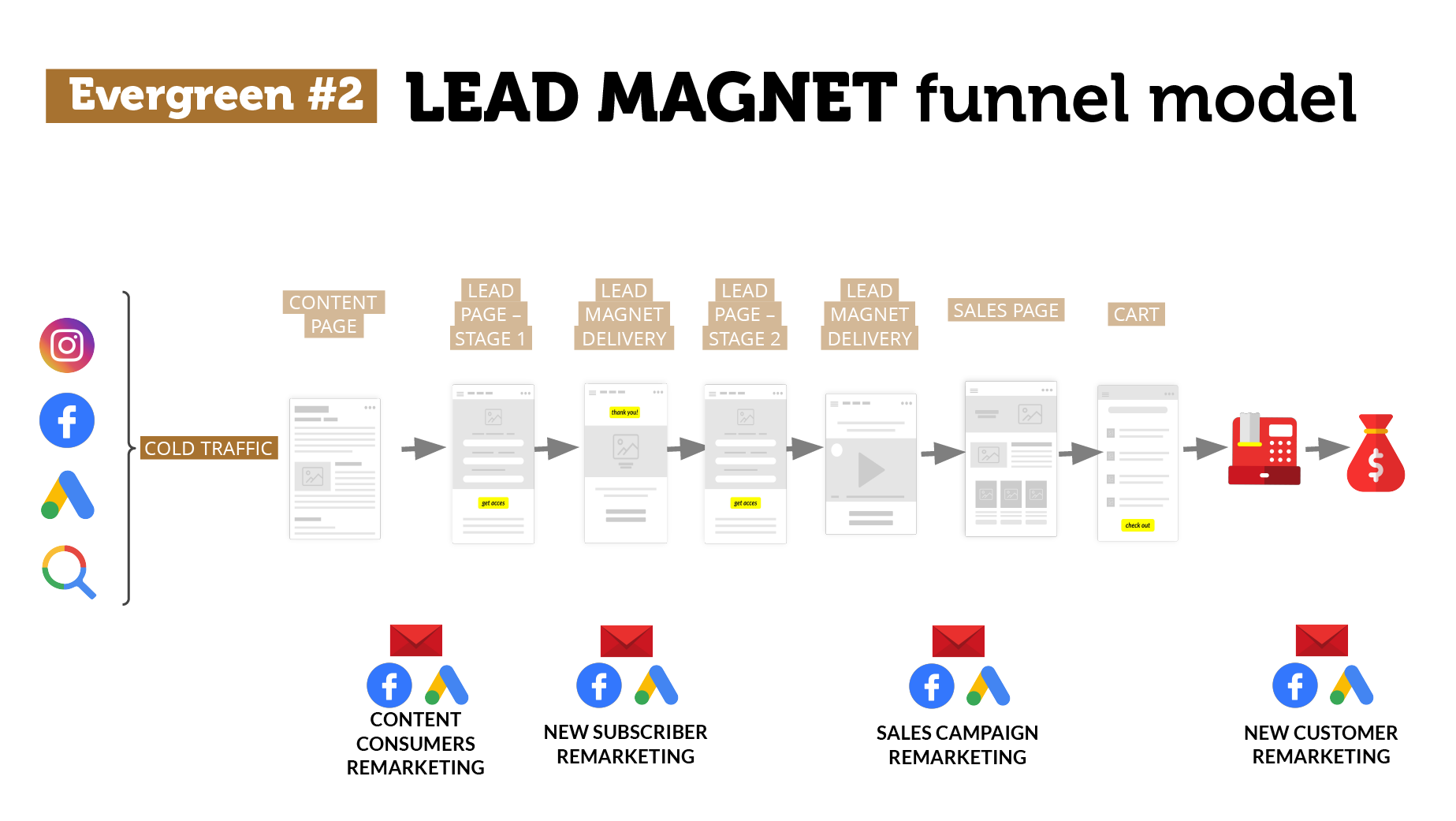
3. Tripwire Funnel
For whom?
Any B2C business
Probably the most underappreciated and misunderstood one, so let’s dive a bit deeper here.
The term might sound a bit shady, but fear not — it’s a totally ethical approach… although it is a teasing game. This is the moment when that quiet Evergreen spices things up a bit. Still, waters run deep, as they say.
Marketing and advertising pros have been using tripwire campaigns for decades in brick-and-mortar stores. Today, being able to take it online only works to your advantage, as you can stay in touch with your customers more easily.
How does it work? Use a so-called low-ticket product as a tripwire to inspire a high-ticket product purchase. What’s crucial here: a tripwire needs to be top quality and deliver so much value that it doesn’t only defend itself, but also speaks volumes for your brand and convinces people they want more.
It has to feel like an irresistible deal, pretty much a no-brainer with its low risk, low level of entry, and low commitment.
The real hack here is: you want to upsell them immediately — while they’re purchasing the tripwire — with your core products. So focus on split testing and optimizing your cart, upsell, and even checkout pages.
Even better if you have some type of subscription offer at your backend. Whether it’s for a physical or digital product, it would just crown the entire funnel by minimizing the CAC and maximizing your ROI right out of the gate.
Because of that, this funnel works great with paid media campaigns — and last year hasn’t changed it. Speaking from experience. We’ve observed that since the first lockdown, it became increasingly harder to get ROAS (Return on Ad Spend) on social media, especially on Facebook — but Tripwire is definitely still cashing in.
What numbers are we talking about? If you set up everything right, you can aim for 100% ROAS already with the tripwire purchase (the cheap “teaser”)… And further 300%+ ROAS on core product upsells and subscriptions, over the following 90 days after that first tripwire purchase. How about that for a tease? Let’s keep going.
Here are 3 types of tripwire you can use:
- Offering a free physical sample or a mini product while letting the customers pay for shipping and handling.
Yes, it can be part of your digital campaign! There are quite a few traps to watch out for… like attracting people who love freebies and promos, and who might mess up your conversion rate from the sample to the end product purchase. They might be very willing to jump on the sampling campaign, but they will not purchase the main product. That’s why you want them to pay for something — like shipping and handling, for example.
- A small and cheap physical or online product
This product can be one segment of your core product (for example one chapter from your online course). OR a small stand-alone that compliments or strongly relates to your core product.
For example: if your core product is an online course on public speaking, a tripwire could be a (cheap, not free!) micro tutorial on how to prepare a drop-dead-gorgeous Keynote presentation.
- A cheap trial of the core product.
Play with this if you’re running a subscription.
An obvious example: the access to an online yoga & fitness studio is $1 for 14 days (with a standard price of $29 per month).
Another one: a home-delivered wine subscription that’s usually $90 per month, as a tripwire could offer the first box for $19. To make it work, these wines would have to be pretty rare, maybe even exclusively made for your brand — definitely not available at your local supermarket.
Yet another one: if you’re running a coaching or consulting business, offer a first consultation call at a ridiculously affordable price, for example, $15 for an hour (if your usual rate is $100+ per hour).
How is a Tripwire Funnel different from a Lead Magnet Funnel?
Unlike in the Lead Magnet Funnel, here you’re not giving them anything completely for free — they have to pay for something, and so you immediately turn them into customers.
How is a Tripwire different from a discount?
The goal of a discounted deal is to boost conversions AND profits. Meaning, you can only offer a nominal discount that does not kill your profit margins.
On the other hand, the goal of a tripwire is to quickly convert as much traffic as possible into customers. Meaning, that when offering a tripwire, you are usually NOT fixated on making a profit.
In fact, you might initially notice a loss because you are offering a high-quality product at a very low cost. That’s why your upselling game needs to be strong, so you can catch up on the profits.
Again: focus your optimization efforts on the CART, UPSELL, and maybe even checkout pages.
In terms of remarketing, you want to target your persona all the way from viewing your Tripwire Sales Page to abandoned checkout to new customer remarketing — and that includes buying the core product. Unless they already bought everything there is from you, including a subscription — then just make sure they stay satisfied with your product and customer service, so they recommend you to their friends. This will improve your ROAS, too. ????
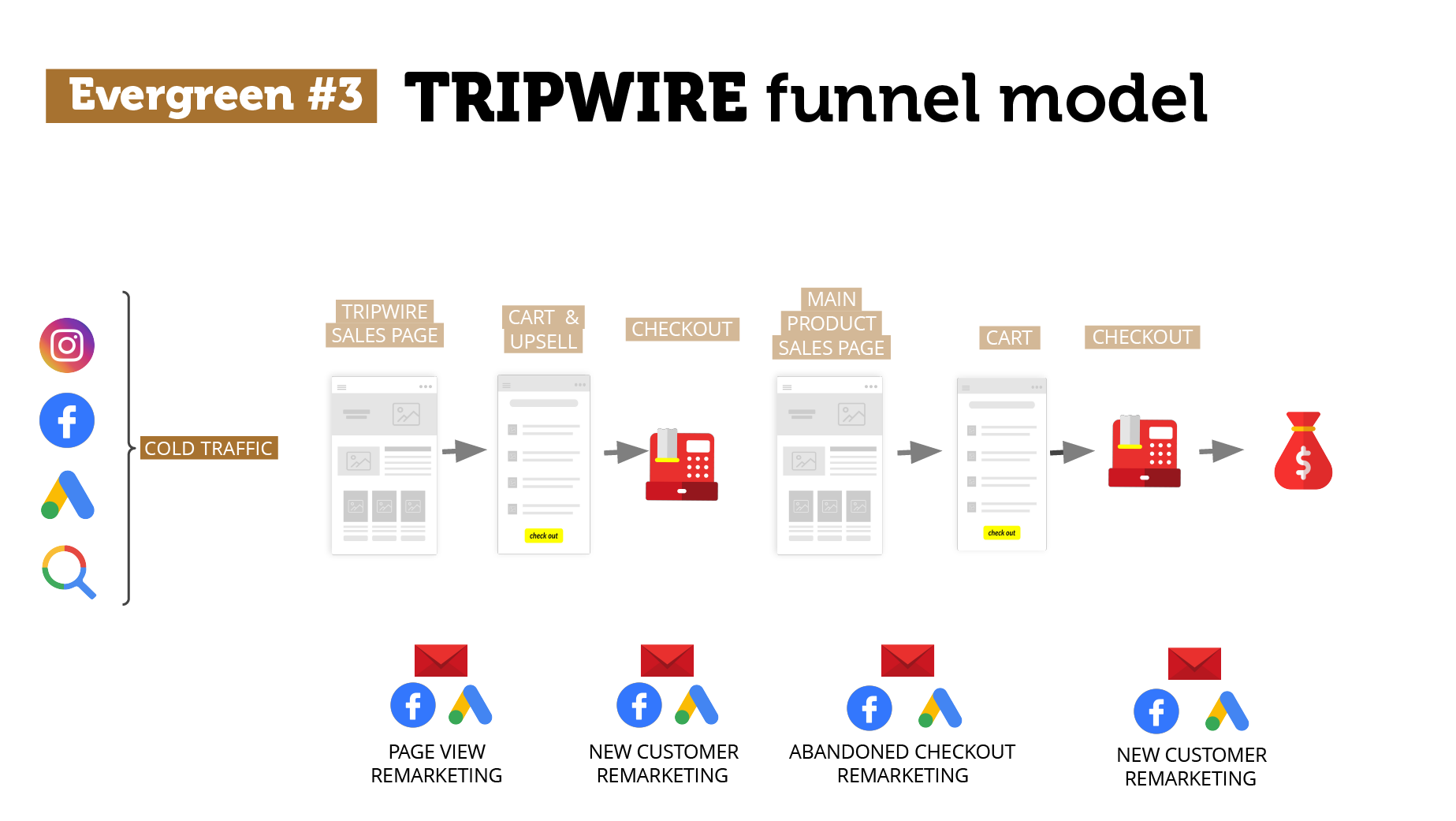
These are our favorite 3 types of Evergreen Funnel. Now, if you need an action plan, here’s how to work on an Evergreen Funnel, ultra simplified:
- Choose your funnel and its flow — you can copy or innovate on the flows above.
- Remember to combine it with at least one Launch Funnel.
- IMPLEMENT IT. Might sound silly — but your idea is only as good as its execution.
- Keep measuring it & optimizing it. It’s called “evergreen”, but you don’t want to leave it completely unattended. Focus on: remarketing strategies, conversion rate, purchase value, order frequency, etc.
The Launch Funnel
Okay, it might be more fun, but it’s also more hustle, sometimes even hassle. If you’re only running Launches — no matter how successful they seem — but you’re not leaning on the gentle shoulders of the Evergreen, I can tell you upfront: you’re burning your potential.
A little party never killed anybody… but too much party definitely did!
What is a Launch Funnel and how to use it? It’s another type of sales funnel that you unleash when you want to maximize your revenue in a short period of time — and when you already have a warm audience, usually thanks to the Evergreen Funnel.
As mentioned at the very beginning, there are 3 types of Launch Funnel:

1. Seasonal Promo
For whom?
Any B2C business
Use a Seasonal Promo Launch funnel by emphasizing scarcity and limited availability to boost sales — in terms of time, the quantity of the product, or to whom it is available.
For example:
“Only 10 spots/ packages left”
“Last pieces sale”
“Only 24 hours left”
“A secret sale for the members/subscribers only”
Or “A discount for the first 500 people,” etc.
???? A little hack for you: create a pre-promo to promote the seasonal promo! **mind blown**
This technique works great especially when you’re offering huge discounts over a super short amount of time — like Black Friday sales that usually happen only over one day. Combine a tease with a countdown for the best effects.
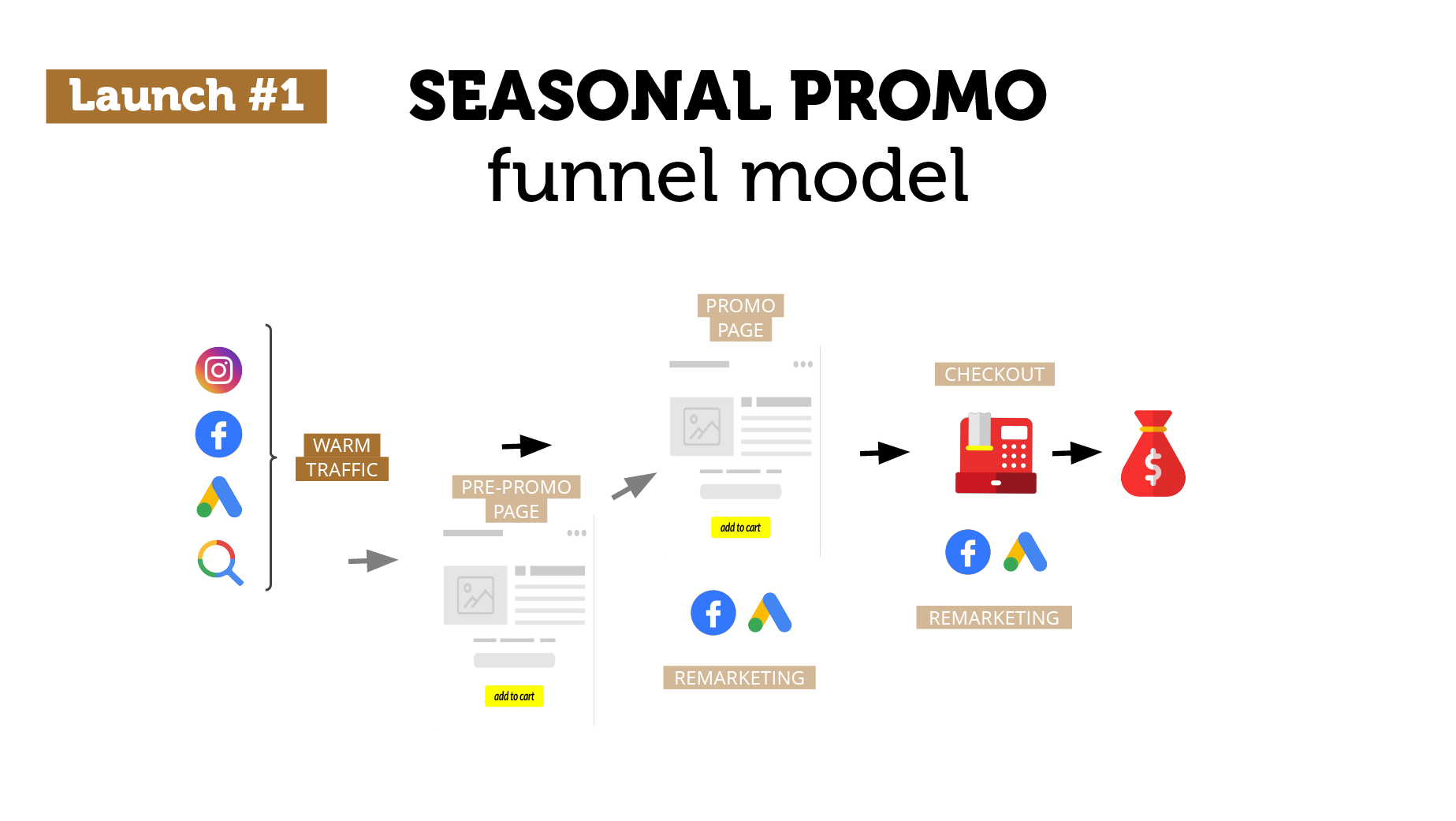
You can play with 3 types of Seasonal Promo Funnel:
- Monetary incentive aka a discount
Tip: Count both “% less” and “$ off” options, and choose the one that has a significantly higher number. For instance, choose an “$80 off” discount over a “10% discount” for an $800 product. The actual gain remains the same, BUT the perceived benefit of saving $80 will be more attractive for the customer to finalize the purchase.
- A bonus or a freebie
Like: free gifts, free delivery, BOGO (Buy One Get One), participation in a lottery, etc.
- CSR = Corporate Social Responsibility
All types of charity donations and awareness campaigns. Watch out though — this one often goes horribly wrong, if the Launch is not aligned with the brand values (or, even worse, the brand is not value-driven), or the cause is not relevant, or the donation % doesn’t feel enough to the audience.
2. Challenge
For whom?
Subscriptions & online education
A Challenge Launch Funnel starts with an exciting online event that lasts anything from a few days up to several months. It can sometimes seem tricky, but it can really help to build a relationship with your audience, as they feel better/ stronger / more skilled/ more empowered by the end of the Challenge.
And because you’re targeting the warm audience, if you play your cards right, you might even get a 10x lower CAC than in the Evergreen funnel (but obviously you’re able to do it mainly thanks to the Evergreen, not in isolation).
Now, there are 3 main approaches to it:
- You can sell the Challenge itself and then upsell your core product (online course, academy, or subscription) on the cart page or in remarketing.
- The Challenge itself is free, but they have to sign up for your list to attend it (Lead Magnet!). You can then send them the Challenge directly in your email or through private/ unlisted links. You then upsell them with your core product. These options obviously allow them to share the Challenge contents with others, which might be both good and bad, depending on what you want to achieve. If you’re happy with the word-of-mouth marketing, this can work great. However, if you strictly want to gather Leads, then you have to make sure that everyone has to sign up to get access — so deploy logins with passwords at some stage. OR consider the next option…
- The Challenge itself is free or kind of free or discounted, but they have to register into your platform to see it — so it’s happening inside your academy or subscription playground. Then it’s your choice whether you charge them for it and how much, is the access discounted, how much of the rest of the platform can they see (again, it’s a teasing game), etc. Of course, the goal here is to upsell the core product, ideally both inside the platform and in remarketing. Another big win with this approach: launch these Challenges regularly and keep them available to the current clients for free. It will help you retain your subscribers, as you keep them interested and engaged.
Some crucial elements of the Challenge Launch Funnel:
- Start promoting the challenge at least 2 weeks before it starts
- Prepare an opt-in or sales page with the challenge start date and duration
- Emphasize the value of community (if available) and doing the Challenge together
- Deploy time-sensitive remarketing ads (the countdown is on). Keep reminding your audience (including the people who bought/signed up!) when the challenge kicks off because it pushes them to show up. Create a feeling of momentum and community. All of this will help you not only create value but also maximize the revenue at the end.
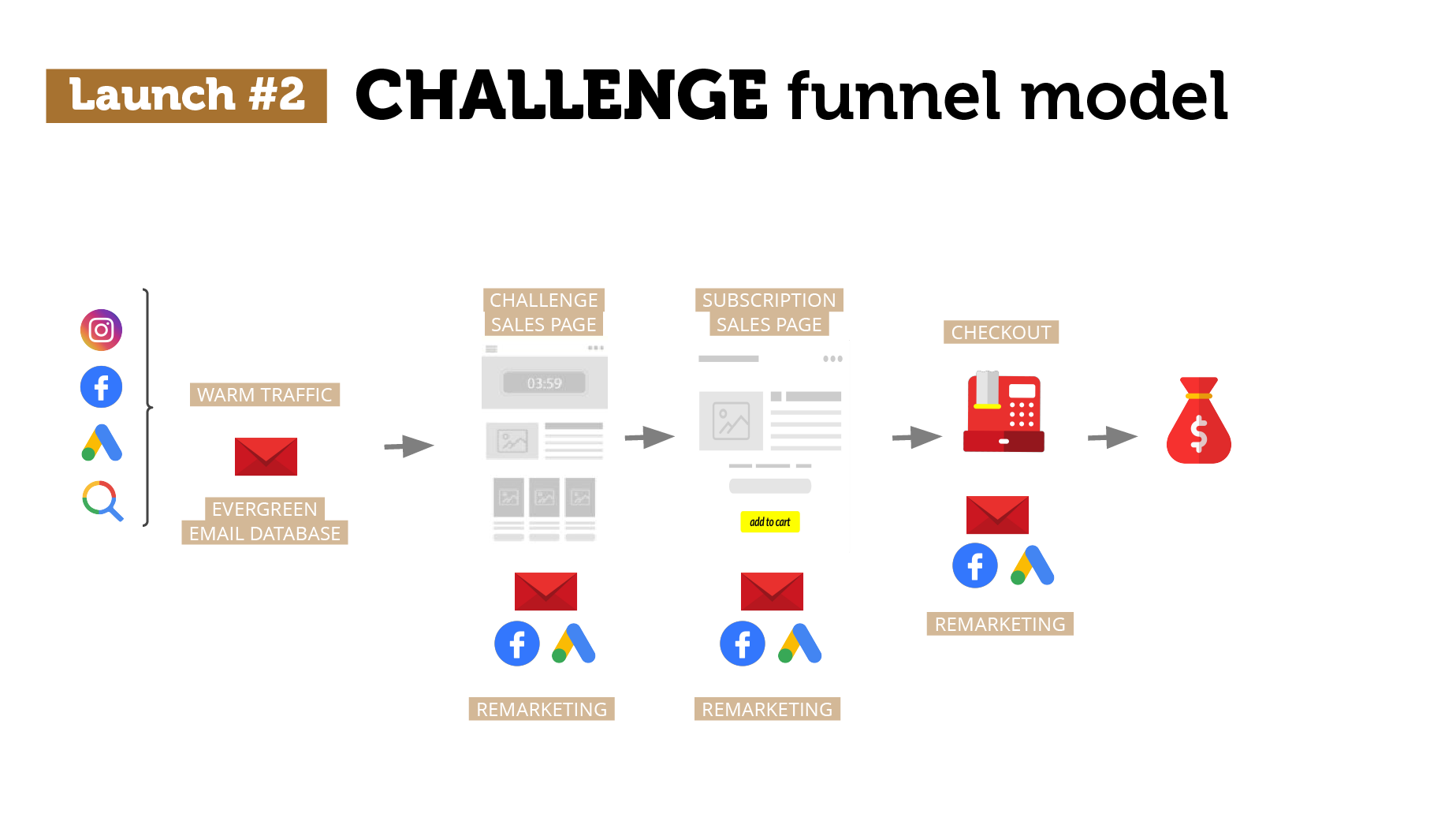
3. Live Webinar
For whom?
Online education, possibly a subscription
Definitely one of the most popular types of funnels. Simply put a Launch Funnel with a short online event — a live webinar. The webinar is clearly live (not pre-recorded), but replay is available for 24-36 hours only. You sell during the webinar and after it, and the entire campaign can last up to 21-30 days.
Please mind that when it comes to revenue and profit, live webinars work better when selling expensive products. Emphasize a special webinar offer (a juicy discount or irresistible bonus) and follow it up with a discount ladder.
If you want to sell a very cheap product with a low margin on the webinar, you need to have a HUGE crowd of attendees. And you’ll only get that if you combine an almighty Evergreen with a massive affiliate launch. A cheap product also doesn’t leave you much space for a discount ladder. Generally, not the best match.
Although extremely popular, at Tribe47 we’ve noticed that not that many people do it effectively or even correctly. Personally, I’ve been working with this type of funnel for over a decade, and I’ve tested almost every possible configuration under the sun (I say “almost”, because there is always space for innovation).
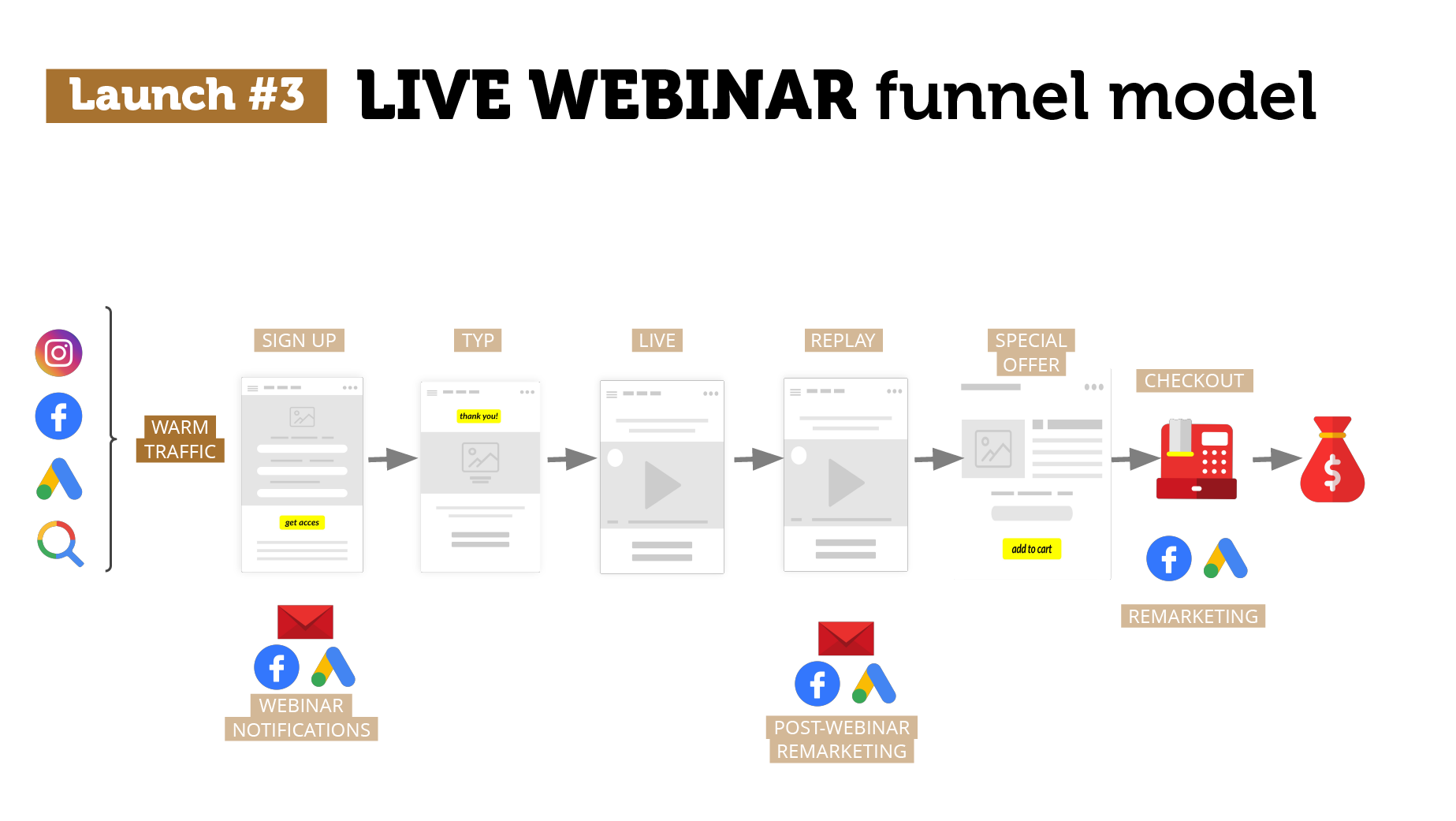
Now, if you need a general and simplified action plan on how to work with any of these 3 Launch Funnels, follow these:
- Choose your funnel and its flow — you can copy or innovate on the flows above.
- Give yourself at least 6 months (!) to plan everything ahead.
- Launch ????
- Keep measuring, optimizing, and relaunching.
- Have fun.
However, if you need more support, get in touch.
We’ve already helped hundreds of entrepreneurs from all around the world — from Malaysia to Ireland, to the US — and it would be our pleasure to help you skyrocket and scale your business.



